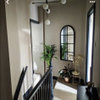Cheapest way to build a side return
My daughter has just bought a GF flat in a Victorian terraced house in SW London. When converted in the 1970's(?) a bathroom was added at the back, off the kitchen which incorporates a staircase from the upstairs flat out to their back garden - very typical of the area. We (parents) are experienced in renovation & drew up a v modest plan to add a narrow side return, including a new party wall as there is only a fence at the moment. No drainage issues or other complications. Although the return is narrow (1.4m), it would make a huge difference to the space and add privacy from next door.
She is on a limited budget and I don't think it's worth doing anything larger as the value of the property will always be limited - 1 bed with a shared front door & internal 'front' doors at the bottom of the stairs. The one builder who has visited the site was expensive - assuming traditional building materials - block wall, slated roof with Velux windows rather than steel frame and glass to keep costs down and avoid visibility from upstairs flats. There is no rear access, so we understand why costs are higher.
Has anyone experience of cheaper ways of doing this using alternative building materials? We are wondering if there are any prefabricated wall panels which might suit - possibly requiring shallower foundations which seemed to be a major cost? Any alternative ideas welcome. Thanks.

Reload the page to not see this specific ad anymore

Studio O+U Architects
Studio O+U Architects
Roger Connolly
Studio O+U Architects
Tholos Architects